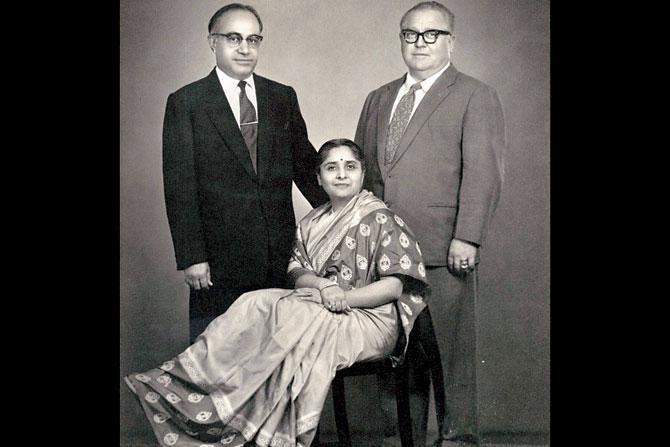Eighty-five years ago, on February 14, the Kamdars started carving a niche in Art Deco furniture which vaulted them to household name and fame

Managing Director Vikram Kamdar and his wife Nandini, company director and CEO, with their daughter Priya in the Kamdar showroom at Churchgate. Priya and her brother Haren (not in picture), both board directors, are the future face of Kamdar. Pic/Ashish R
 Quit India, the freedom stalwarts said. And Bhagwandas Morarji Kamdar quit his job. The bright young civil engineer-s conscience stung, aware that the plum government post he enjoyed was British-controlled.
Quit India, the freedom stalwarts said. And Bhagwandas Morarji Kamdar quit his job. The bright young civil engineer-s conscience stung, aware that the plum government post he enjoyed was British-controlled.
The 1930s heaved in political ferment, with Bombay the pulsing core of the independence struggle. Bhagwandas got a personal jolt when his father-s second wife Ramaben, patriot and close ally of Kasturba Gandhi, was jailed.
Fond of woodwork, which he-d chosen as an ancillary course at Pune-s College of Engineering, Bhagwandas began moulding fine-finished Montessori blocks, waxed and hand-painted to distribute in schools. Until his Nepeansea Road neighbour, Rameshwar Das Birla, asked to make him a dining table. Bhagwandas did, sawing away in his garage. That was his foray into furniture.

Watercolour by Messerschmidt showing the Maharani of Morvi’s dining room, whose long banquet table was made by Kamdar
Bhagwandas- son, 75-year-old Vikram Kamdar, unhurriedly shares ancestral anecdotes at the Churchgate showroom the family has occupied since 1940. Located at Industrial Assurance Building, in the heart of a resplendent Art Deco haven, the Kamdar repertoire rose as if responding to this vantage ambience. Across the road from Eros Cinema, the company hub is ringed by Deco-dressed residences. Sleek, clean, confident, this genre of architecture and furniture - where striking geometrics and metallic finishes met dramatic accents and sweeping curves - initially wowed the world at the Exposition Internationale des Arts Decoratifs therefore Art Deco in 1925 Paris.

A Hamilton Studio shot of Bhagwandas Kamdar and his wife Pushpa, with their furniture firm-s stellar design head, Ernst Messerschmidt, who arrived in India to furnish Indore-s Manik Bagh Palace in Art Moderne style around 1930. Art Moderne - an American, intense version of Art Deco which originated in France - is described as "Art Deco on steroids". Coutesy/Vikram Kamdar
Though quick to embrace that modernist trend a decade after its global debut, the Kamdars have rural roots. In the Kutch village of Dumra of the 1800s, Bhagwandas- father, Morarji Mathuradas Kamdar, saw his father die early. Mathuradas- widow was compelled to work in wealthy homes. Distantly related to a childless tycoon in Walkeshwar, who wanted to adopt her son, she came with 13-year-old Morarji to the Banganga haveli Bhatia Niwas.
A Bharda High School pupil, Morarji, solely conversant in Kutchi till he reached the city, topped his Matric class in English. Excelling in the language for the BA degree year at Elphinstone College, his prize was a three-volume leather-bound Shakespeare edition.

Kamdar dressed up the Rendezvous, the Taj-s fashionable French restaurant. Coutesy/Vikram Kamdar
A function in his Sethia benefactor-s home proved the tipping point, Vikram recalls - "Morarji was determined to attend his exam instead of a puja marking the occasion. Taunted by the foster father about his humble background, he packed his bags to leave. A friend sheltered him while he gave math and English tuitions, completed law studies and set up a solicitor firm."
Morarji and his wife Mungibai-s third child, 1903-born Bhagwandas followed his father-s Bharda-to-Elphinstone academic journey, except that his was towards a science degree. Morarji proudly gifted a Buick convertible in 1926 to his son who soon moved from promise to prosperity, founding Kamdar Karyalaya in 1934. This workshop shifted to Kalachowki in six years. At the Churchgate premises Bhagwandas and his team advised clients on colour, lighting, composition and accessories. "I-m proud of the association Kamdars had with iconic Art Deco establishments like Markel lights way back in the 1930s," says Vikram.
In the absence of interior design schools, Kamdar recruits had an applied arts background. Master craftsmen pooled their carpentry, upholstery, polishing and metalwork talents for furniture everyone aspired to. They outfitted plush hotspots - Rendezvous at the Taj, the cafes Napoli and Volga, the Swissair reception office, the James Finlay showroom. Bhagwandas Kamdar steadily won customers across India, Europe and the Middle East. With his easy chairs, sofas, nursery suite, tapestries and carpets came innovations too. One was the ragingly popular "kamette", a settee reclining flat at the touch of a light spring. It was used as an additional bed in homes or in offices by top brass grabbing a siesta in private cabins.
"My father-s forte was customisation," says Vikram. "We had more bespoke orders than walk-in buyers." To meet the mounting business volume, the artist Ernst Messerschmidt was invited to join the design department. The assignment bringing him to India by 1930 had been the Holkars- Manik Bagh Garden of Rubies Palace in Indore.
"Messer stayed in Bombay on losing his East Germany home," Vikram says. "He upgraded and refined our entire studio culture. My passion for design sparked by him, I went to J J College of Architecture. Watching Messer run the company with my father taught me manufacturing and production. I learnt about factory machinery, timber trade, sawmill processes, wood seasoning and storing."
The post-1947 abolition of princely states slapped on an inevitable slump in sales. Kamdar engineered its revival with optimistic publicity. The upbeat ad copy framed by SH Benson, eventually one-third of Ogilvy Benson and Mather, stretched from simple "Our prices are wickedly low compared with the quality" to deliciously detailed "This lounge with deep cushions, its modern lines and richly grained polished teak ends relieved by rosewood legs, is for discriminating lovers of beautiful furniture. May we send you sketches and quotations?" Such inviting suffixes to the text were their trademark.
A saucy ad actually read: "What goes on behind the curtain? We don-t know, we can-t tell, we-re not nosey for other folks- affairs. But ain-t that just a lovely curtain?" Another campaign line exulted, "Rampant materialists, we… and proud of it!" This printed on an interesting date. December 23, 1940. "With war news front-paged daily, here was Kamdar asserting -We think design matters-," says Abigail McGowan, Associate Dean of the College of Arts and Sciences and Associate Professor of History at the University of Vermont. Writing a book that explores the ideals of home in 20th-century Bombay, she explains - "I-m focusing on people and institutions that tried to reshape spaces lived in, how they filled and understood those spaces."
Architect Shrikant Sathe says, "My father Laxman Vishnu Sathe of the prolific Art Deco trinity, Master, Sathe and Bhuta told me Kamdar was skilled at accommodating furniture in places architects envisioned. Maximising any area provided, their furniture was contemporary, lasting and suited to a purpose. I was introduced to Bhagwandas and Messerschmidt while extending the Mafatlal bungalow on Altamont Road in 1963. My father had drawn three existing storeys in the 1930s. Rasesh Mafatlal commissioned Kamdar to furnish the new fourth floor. They brought layout ideas but no changes to my main plan, nor to windows, doors or flooring. Their perspectives matched mine perfectly.
"It was the same with two levels added in 1965 to their Nariman Point building. The sixth was an office floor like lower ones already executed by my father-s firm. The seventh, with terraces on three sides, was a lunchroom, retiring room and discussion room. I introduced large glazed north-side windows. Here too their plan did not interfere with my design."
Kamdar-s 25th anniversary brochure noted, "In the 1930s, when we ventured into the fascinating world of Furnishing and Interior Decoration, there was little consciousness or appreciation of the subject. People today take a keener interest in their surroundings. We at Kamdar-s have steadfastly worked for this awakening."
Theirs was also a democratic ethic. Never mind the Birlas, the Mafatlals, the royal houses of Baroda, Gwalior, Hyderabad and Jaipur not forgetting exclusive radio cabinets contoured for the Maharaja of Patiala, all patrons with limitless budgets. Bhagwandas especially loved couples starting out life together, shyly confessing they came with small means but big dreams of possessing a Kamdar piece.
Theatre personality Sabira Merchant remembers, "When Chhotu and I were marrying in 1959, I was barely 17. We sat with Vikram-s dad. For what we were able to afford, he had Messerschmidt and the Russian designer Primakoff give us what I can only call indestructible furniture we never tired of: a semi-circular sofa with bold black-and-white stripes, the round dining table I believe best for mealtime communication, and our bed which remains the same but for a headboard originally in brocade fabric from the Indian Textiles shop. My Burma teak cupboard shone with chromium rods to drape saris. It pleased me no end to create The Sabira Chair, upholstered to its arm tips and with a slightly slanted back."
The company once held sway amid reputed names, including Interfurn, Chippendale and Nuha. "We now face affordable competition, plus the whole shift of living lies northward beyond Bandra," says Nandini Kamdar, Vikram-s director-CEO wife. Formerly Naqi Jehan, acting in 1960s movies like Aakhri Khat with Rajesh Khanna, Nandini clinched the 1967 Miss India title. Twenty years before that, her beautiful mother Esther Victoria Abraham was crowned the first Miss India in 1947 – aged 31 and pregnant with a fifth child – in days the rules were not yet set.
As Pramila, her screen sobriquet, Esther was a stunt star mostly playing the Westernised vamp. Importantly, she went on to become a pioneer woman producer with 16 films credited to her Silver Productions banner.
"Before knowing Vikram, I grew up with four brothers whose rough ways my family-s Kamdar range withstood for years," laughs Nandini. "Those boys swung on chairs, kicked footballs inside the house. Hearing our parents boast that no iron could burn Messerschmidt-s imported upholstery, in floral maroon, they even decided to test that! Luckily it wasn-t a false claim. I later discovered Kamdar always honoured its tagline, -A tradition of trust-."
Author-publisher Meher Marfatia writes fortnightly on everything that makes her love Mumbai and adore Bombay. You can reach her at mehermarfatia@gmail.com/www.mehermarfatia.com
Catch up on all the latest Mumbai news, crime news, current affairs, and also a complete guide on Mumbai from food to things to do and events across the city here. Also download the new mid-day Android and iOS apps to get latest updates
 Subscribe today by clicking the link and stay updated with the latest news!" Click here!
Subscribe today by clicking the link and stay updated with the latest news!" Click here!









